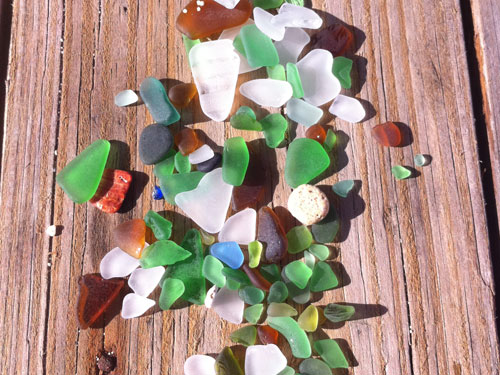 As Hurricane Sandy’s powerful winds and roaring storm surges enveloped the beaches of the Abaco Islands in the Bahamas, its tumultuous erosive forces stirred up hidden gems of history and beauty. Long lost to the depths of the ocean, pieces of glass from broken wine glasses, bottles, mirrors, and many other sources are transformed by time and the tide into unique, unrivaled jewels. Sandy’s turbulence unearthed an unusual amount of sea glass, including some rare colors and unique shapes.
As Hurricane Sandy’s powerful winds and roaring storm surges enveloped the beaches of the Abaco Islands in the Bahamas, its tumultuous erosive forces stirred up hidden gems of history and beauty. Long lost to the depths of the ocean, pieces of glass from broken wine glasses, bottles, mirrors, and many other sources are transformed by time and the tide into unique, unrivaled jewels. Sandy’s turbulence unearthed an unusual amount of sea glass, including some rare colors and unique shapes.
Representatives from Card Sound Creations, a producer of sea glass jewelry, stumbled across Sandy’s gift of sea glass while visiting the Bahamas in November of 2012. While the most common colors of sea glass are green, brown, white, or clear, Card Sound’s reps were lucky enough to pull a number of rarer colors, including a stunning, perfectly round aqua piece. “Following Sandy, we had a much more impressive pull of sea glass, both in quantity and quality,” said one of the sea glass enthusiasts. “It was obvious the erosion and storm surge dredged up some very old and very beautiful pieces.”
True sea glass has a distinct feel and look that cannot be replicated. The worn edges and opaque, etched texture give sea glass the feel of the ocean, which can only be created over years of wave and sand erosion. The naturally frosted glass also holds an intangible charm in the obscurity of its origins; sea glass can come from anywhere in the world, and any source imaginable. From 100-year-old spirit bottles tossed into the ocean or chunks of stained glass windows from wrecks of galleons, sea glass is as mysterious as it is beautiful.
The rarest colors of sea glass are red, orange or citron, cobalt, cornflower blue, aqua, and lavender; these are found one for every 200 to 1,000 pieces found. The color of the sea glass directly correlates to the era in which in originated, which gives some colors an age.
Shape is also a way to determine age, as normally the more symmetrical a piece, the older it most likely is.
Extremely rare colors include pink, often from Great Depression-era plates; teal, from Mateus wine bottles; black, which is normally the result of older, very dark olive green glass spending years being etched; yellow, often from 1930s Vaseline containers; turquoise, from tableware and art glass; and red, often from old Schlitz beer bottles, dinnerware or nautical lights.
Red is found once for every 5,000 pieces, and orange is found once for every 10,000 pieces. Part of the reason these colors are rare is that glass making 150 years ago was very different than it is today.
To make red, yellow, pink, or orange glass was expensive, and so less common than typical colors like green and brown.
Sea glass can be found anywhere in the world, and could originate from anywhere in the world, from pre-industrial England to shipwrecks in the Caribbean.
While sea glass can be manufactured artificially by placing glass shards in a rock tumbler, they lack the feel and romanticism that comes from years rocking in the waves.
The true charm of sea glass comes from its history, and the beauty created by the constant caress of the sea. Card Sound Creation’s unique hall from the aftermath of Hurricane Sandy have been crafted into stunning pieces of art in the form of bracelets, earrings, and anklets.
If you ever find yourself strolling a beach at dawn or in the throes of a magnificent sunset, be sure to keep an eye on the sand for the tell tale sparkle of sea glass. It may be a jewel of the ocean, lost to the sea and waiting to be found.
By: Fish On! PR


